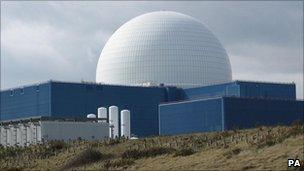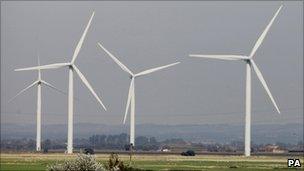The importance of infrastructure investment
- Published

More nucleur power stations is a key infrastructure aim of the coalition government
The need for infrastructure development is one of the great global challenges of our time.
In fact there is probably no bigger question for public policy worldwide.
Not only do the new big economies like China and India need more and better infrastructure, we are at a point where a lot of the ageing infrastructure in Europe and the US needs replacing.
We need better roads and railways, nuclear power plants and wind farms to meet our sustainable energy needs, schools and hospitals.
Failure to invest means failure to grow and develop our social and economic fabric - we all have a stake in this.
Experts estimate that about $40tn (£25tn) is needed globally to build or upgrade roads, railways, power plants and other infrastructure in order to keep up with demand.
According to the Treasury, in the UK alone infrastructure spending may need to run at £40bn to £50bn each year up to 2030.
Five sectors
The way countries tackle their infrastructure deficit will determine their future.

The Olympic Park is seen as a major infrastructure boost for London
The UK government has now grasped the magnitude of the challenge.
The National Infrastructure Plan published by the government on 25 October is an important step forward in recognising the importance of infrastructure to the UK economy.
Nothing on the scale of it has been attempted before in the UK, though similar plans exist or have been tried in other countries such as Australia, India and Spain.
The plan will provide a framework to identify and prioritise the infrastructure investment needs of the country, and to facilitate their delivery.
It crucially identifies five infrastructure sectors: energy; transport; digital communications, flood management, water and waste; and intellectual capital, and suggests that over the next five years £200bn will be invested in these sectors.
Only in part will the £200bn investment challenge be met through public sector funds, the vast bulk - more than three-quarters - will be delivered through private sector investment.
The plan, however, acknowledges a role for government in creating the right conditions for investment, even where that investment will be private-sector led.
The conditions include - critically - a stable, long-term horizon in terms of planning, political and regulatory certainty, and financial contributions from government.
Long-term view
Although the plan as published is disappointingly silent on timescale, Infrastructure UK, the Treasury division responsible talks about taking a 50-year view.

The UK needs more wind farms to increase its sustainable energy base
That is what the private sector needs if it is to invest with confidence in what are very long-term assets.
The plan also intends to improve the quality of information available regarding the UK's infrastructure.
This could in time become an official, transparent and public account of the state of the nation's infrastructure.
In fact, this has always been a key problem - public authorities in most of the world fail to maintain a proper asset register for infrastructure or a balance sheet that allows for its depreciation.
And because infrastructure is not measured properly, it is not managed properly.
As most infrastructure decays at a glacial pace, no one is aware of the state of things before they start falling apart.
The National Infrastructure Plan will finally start to address that problem.
Overseas example
As much as the government is beginning to rise to the infrastructure challenge, what we really need is a change of awareness among the public.
Many of us take it for granted to have fresh water, roads, hospitals and schools for everyone, but in the future the question of who pays for all of that will become much more critical.
A few months age KPMG published its Infrastructure 100 list, external, a report that showcased 100 of the most ambitious and exciting infrastructure projects from around the world.
Among the UK projects that made it on the list were the future London Olympic Park, the London Gateway Port and the Evelyn Grace Academy in Brixton, but the most notable projects, chosen for their scale, complexity, innovation and impact on society, came from other countries.
Among the Top Ten of the Infrastructure 100 is the Venice MOSE Flood Barrier project, which is one of the biggest public works projects in Italian history and will use compressed air to raise flood gates to protect Venice from flooding.
In the US, the Green Power Express is a proposed 3,000 mile network designed to transmit 12,000MW of renewable energy and thus address the transmission issue which is currently the biggest bottleneck facing the development of clean energy.
On the other side of the world, the Hong Kong-Zhuhai-Macau Bridge has been designed with a service life of 120 years and can withstand the impact of an earthquake measuring eight on the Richter scale.
One of the countries' most technically complicated engineering projects; this requires the creation of several artificial islands and will reduce the travelling times from Hong Kong to Zhuhai from 4.5 hours to about 40 minutes.
Once built, the Incheon tidal power plant in South Korea will facilitate 44 water turbines, and will be five times bigger than the world's current biggest tidal plant.
In a country like South Korea, which lacks an abundance of natural resources, this represents an ambitious - but necessary - project and could be a landmark for tidal power.
All these projects have one thing in common - they will contribute to the economic growth of their countries and improve the lives of millions of people.
They will hopefully be an inspiration for new infrastructure projects in this country and elsewhere.
The infrastructure challenge won't be solved overnight, but the National Infrastructure Plan is an important step in the right direction.